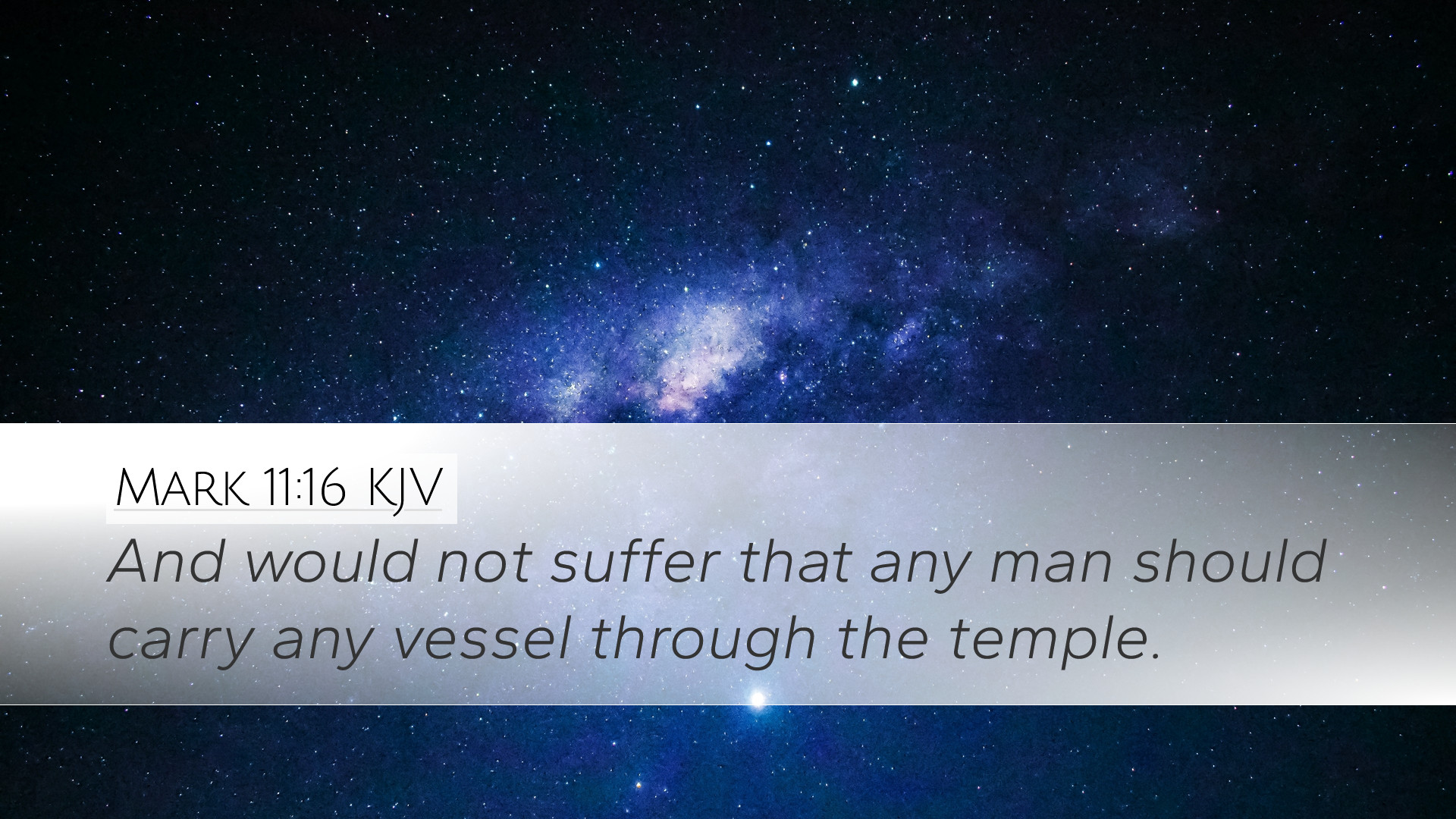Commentary on Mark 11:16
Mark 11:16 states: "And would not suffer that any man should carry any vessel through the temple." This verse is part of the account where Jesus cleanses the temple, an event that holds profound significance within the context of His ministry and the understanding of the temple's purpose. The following commentary draws from various public domain sources to provide insights valuable for pastors, students, theologians, and scholars.
Contextual Background
Mark 11:16 is situated between significant events in Jesus’ final week before His crucifixion. Following His triumphal entry into Jerusalem (Mark 11:1-10), Jesus visits the temple, where He confronts the corruption present within its walls. The temple, intended as a house of prayer, had been turned into a place of commerce and exploitation.
Insights from Matthew Henry
Matthew Henry notes that Jesus' actions in the temple were a demonstration of His authority. In his commentary, he emphasizes the following key points:
- The Authority of Christ: Jesus acted with divine authority to purify the temple. His refusal to allow any vessel to be carried through indicates a significant act of correction, signifying that the temple was meant for solemn worship and not for commercial activity.
- Symbolism of the Temple: The temple represents the presence of God among His people. By driving out the traders, Jesus was restoring its sacredness and urging the people to respect its intended purpose.
- Call to Righteousness: Henry points out that this act is a call to righteousness for the church. Just as Jesus cleansed the physical temple, so too must believers continuously examine and cleanse their hearts and communities from corruption and misuse.
Insights from Albert Barnes
Albert Barnes offers additional insights into the implications of Jesus' actions noted in this verse. His commentary sheds light on several important aspects:
- Context of the Temple: Barnes explains that the temple was more than a physical structure. It symbolized the relationship between God and His people. Jesus, by stopping the carrying of vessels, was asserting that earthly concerns should not interfere with spiritual worship.
- Legal Implications: Barnes also observes that carrying vessels through the temple was against the regulations of that time. By prohibiting it, Jesus was reminding the people of their duties to uphold the sanctity of worship.
- Prophetic Fulfillment: This action aligns with Old Testament prophecies concerning the Messiah's role in restoring true worship. Barnes emphasizes the importance of recognizing Jesus as the fulfillment of these prophetic traditions.
Insights from Adam Clarke
Adam Clarke's commentary provides additional theological reflections on this verse. Here are some key points from Clarke:
- The Nature of Worship: Clarke underscores the significance of proper worship. He suggests that sincere worship must prioritize spiritual over material matters. Jesus' actions serve as a stern admonition against distractions that detract from sincere worship.
- Theological Implication: Clarke highlights that Jesus’ intervention represents a broader theological truth—that the heart of worship must not be conditioned by human interests or corrupt practices.
- The Exclusion of Worldly Activities: By preventing the carrying of vessels, Jesus was symbolically demonstrating that true worship cannot coexist with worldly distractions and commercialism.
Application for Today
This verse, along with the insights drawn from these commentaries, holds significant implications for contemporary faith practice:
- Examination of Worship Practices: Churches today are called to evaluate their own worship practices and ensure they remain focused on God rather than becoming sidetracked by commercialization or secular influences.
- Reverence for Sacred Spaces: This verse challenges congregations to maintain a sense of reverence and holiness in places designated for worship, echoing the biblical call to render unto God the honor He deserves.
- Call for Personal Reflection: Believers must reflect on their own lives, identifying and removing distractions that inhibit their relationship with God, ensuring that their worship is pure and sincere.
Conclusion
Mark 11:16 captures a pivotal moment in Jesus’ ministry, illuminating His intent to restore the sanctity of the temple and, by extension, guide His followers towards authentic worship. The collective insights from Matthew Henry, Albert Barnes, and Adam Clarke enrich our understanding of this passage, encouraging an ongoing commitment to worship that is undiluted by worldly distractions. This teaching resonates across generations, inviting all of us—pastors, students, theologians, and scholars—to engage deeply in the pursuit of sincere, reverent worship that honors God above all else.


